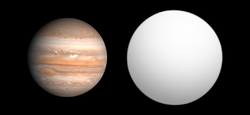Astronomy:HAT-P-14b
 Size comparison of Jupiter with HAT-P-14b. | |
| Discovery | |
|---|---|
| Discovered by | HATNet Project[1] |
| Discovery date | 2010-03-10 |
| Transit | |
| Designations | |
| WASP-27b, Sissi | |
| Orbital characteristics | |
| 0.06062+0.00065 −0.00067 AU | |
| Eccentricity | 0.1074+0.0076 −0.0079[2] |
| Orbital period | 4.627686±0.000077 d[3] |
| Inclination | 84.1167+0.0026−0.0025[3] |
| Star | HAT-P-14 |
| Physical characteristics | |
| Mean radius | 1.101±0.036[3] |♃|J}}}}}} |
| Mass | 2.444±0.060[3] |♃|J}}}}}} |
| 7.49±0.36 g | |
| Physics | 1566±21[3] |
HAT-P-14b, officially named Sissi also known as WASP-27b,[4] is an extrasolar planet located approximately 224.2 ± 0.6 parsecs (731.2 ± 2.0 ly)[5] away in the constellation of Hercules, orbiting the 10th magnitude F-type main-sequence star HAT-P-14. This planet was discovered in 2010 by the HATNet Project using the transit method.[1] It was independently detected by the SuperWASP project.[6]
Host star
The host star is a main-sequence star with the spectral classification F5V and apparent magnitude 9.98, well below the naked-eye visibility limit. It has a mass of 1.386±0.045 M☉, a radius of 1.468±0.054 R☉, and a surface temperature of 6477+13
−15 K.[7][8][5]
History
The planet HAT-P-14b was named Sissi. The name was selected by Austria as part of the NameExoWorlds campaign for the 100th anniversary of the IAU. The planet was named after the character Sissi in the movie Sissi, who is married to Franz. The role is played by the actress Romy Schneider. The star HAT-P-14 is named Franz.[9][10]
HAT-P-14b was selected as the target object for testing the James Webb Space Telescope instruments intended for spectroscopic studies of transiting exoplanets. It was chosen because its high surface gravity should produce a very flat spectrum, regardless of the planet's composition.[11]
Orbit
HAT-P-14b is located very close orbit to its star, taking only 4.6 days to complete one orbit. Observations of the Rossiter–McLaughlin effect with the Keck telescope show that it orbits in a retrograde fashion relative to the rotation axes of its parent star,[12] spin-orbit angle equal to -170.9±5.1°.[13]
References
- ↑ 1.0 1.1 Torres, G. et al. (2010). "HAT-P-14b: A 2.2 MJ Exoplanet Transiting a Bright F Star". The Astrophysical Journal 715 (1): 458–467. doi:10.1088/0004-637X/715/1/458. Bibcode: 2010ApJ...715..458T.
- ↑ Bonomo, A. S. et al. (2017). "The GAPS Programme with HARPS-N at TNG . XIV. Investigating giant planet migration history via improved eccentricity and mass determination for 231 transiting planets". Astronomy and Astrophysics 602: A107. doi:10.1051/0004-6361/201629882. Bibcode: 2017A&A...602A.107B.
- ↑ 3.0 3.1 3.2 3.3 3.4 Saha, Suman; Sengupta, Sujan (2021), "Critical Analysis of Tess Transit Photometric Data: Improved Physical Properties for Five Exoplanets", The Astronomical Journal 162 (5): 221, doi:10.3847/1538-3881/ac294d, Bibcode: 2021AJ....162..221S
- ↑ The Exoplanet Handbook By Michael Perryman, p.727
- ↑ 5.0 5.1 Vallenari, A. et al. (2022). "Gaia Data Release 3. Summary of the content and survey properties". Astronomy & Astrophysics. doi:10.1051/0004-6361/202243940 Gaia DR3 record for this source at VizieR.
- ↑ Simpson, E. K. et al. (2011). "Independent Discovery of the Transiting Exoplanet HAT-P-14b". The Astronomical Journal 141 (5): 161. doi:10.1088/0004-6256/141/5/161. Bibcode: 2011AJ....141..161S.
- ↑ HAT-P-14
- ↑ "The Extrasolar Planet Encyclopaedia — HAT-P-14 b". Extrasolar Planets Encyclopaedia. 1995. https://exoplanet.eu/catalog/hat_p_14_b--650/.
- ↑ "International Astronomical Union | IAU". https://www.iau.org/news/pressreleases/detail/iau1912/.
- ↑ "Approved names" (in en). http://www.nameexoworlds.iau.org/final-results.
- ↑ Rigby, Jane et al. (2023). "The Science Performance of JWST as Characterized in Commissioning". Publications of the Astronomical Society of the Pacific 135 (1046): 048001. doi:10.1088/1538-3873/acb293. Bibcode: 2023PASP..135d8001R.
- ↑ Winn, Joshua N. et al. (2011). "Orbital Orientations of Exoplanets: HAT-P-4b is Prograde and HAT-P-14b is Retrograde". The Astronomical Journal 141 (2): 63. doi:10.1088/0004-6256/141/2/63. Bibcode: 2011AJ....141...63W.
- ↑ Albrecht, Simon; Winn, Joshua N.; Johnson, John A.; Howard, Andrew W.; Marcy, Geoffrey W.; Butler, R. Paul; Arriagada, Pamela; Crane, Jeffrey D. et al. (2012), "Obliquities of Hot Jupiter Host Stars: Evidence for Tidal Interactions and Primordial Misalignments", The Astrophysical Journal 757 (1): 18, doi:10.1088/0004-637X/757/1/18, Bibcode: 2012ApJ...757...18A
External links
- "HAT-P-14 b". Exoplanets. http://media4.obspm.fr/exoplanets/base/planete.php?etoile=HAT-P-14&planete=b.
- "HAT-P-14b in transit". Light curve using differential photometry. http://www.perseus.gr/Astro-Photometry-HAT-P-14-20110618.htm.
Coordinates: ![]() 17h 20m 28s, +38° 14′ 32″
17h 20m 28s, +38° 14′ 32″
 |

